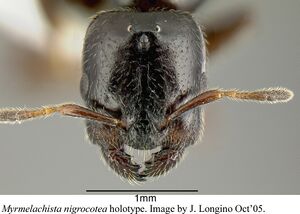Myrmelachista nigrocotea
| Myrmelachista nigrocotea | |
|---|---|

| |
| Scientific classification | |
| Kingdom: | Animalia |
| Phylum: | Arthropoda |
| Class: | Insecta |
| Order: | Hymenoptera |
| Family: | Formicidae |
| Subfamily: | Formicinae |
| Tribe: | Myrmelachistini |
| Genus: | Myrmelachista |
| Species: | M. nigrocotea |
| Binomial name | |
| Myrmelachista nigrocotea Longino, 2006 | |
This species occurs in mature wet forest habitats from 500–1100m elevation, where it nests in live stems of understory Lauraceae and Meliaceae. It has a biology similar to Myrmelachista flavocotea but is more generalized in its host use. At Refugio Eladio in the Peñas Blancas Valley it occurs in Ocotea dendrodaphne, O. atirrensis, O. tenera, and the undescribed species of Guarea that is the host for M. flavoguarea. Cerro Pedregal, across from Estación Cacao in the Guanacaste Conservation Area, has a patch of understory O. tenera near the peak that is dominated by M. nigrocotea. Colonies can be monogynous or polygynous with 2–4 dealate queens. Stems often contain Pseudococcidae. Alate queens have been collected in Project ALAS Malaise traps on the Barva transect. (Longino 2006)
Identification
Longino (2006) - Worker with antenna 9-segmented, maxillary palpus 5-segmented, color yellow. Queen black; mandible punctatorugose; HW greater than 1.1mm; head relatively broad (CI 88–93); eyes relatively small (OI 23–27); much of face slightly roughened, dull, not strongly shining.
Keys including this Species
- Key to Myrmelachista males of Costa Rica
- Key to Myrmelachista queens of Costa Rica
- Key to Myrmelachista workers of Costa Rica
Distribution
Latitudinal Distribution Pattern
Latitudinal Range: 10.99261° to 10.15°.
| North Temperate |
North Subtropical |
Tropical | South Subtropical |
South Temperate |
- Source: AntMaps
Distribution based on Regional Taxon Lists
Neotropical Region: Costa Rica (type locality), Honduras.
Distribution based on AntMaps
Distribution based on AntWeb specimens
Check data from AntWeb
Countries Occupied
| Number of countries occupied by this species based on AntWiki Regional Taxon Lists. In general, fewer countries occupied indicates a narrower range, while more countries indicates a more widespread species. |

|
Estimated Abundance
| Relative abundance based on number of AntMaps records per species (this species within the purple bar). Fewer records (to the left) indicates a less abundant/encountered species while more records (to the right) indicates more abundant/encountered species. |

|
Habitat
In Costa Rica it occurs above 500m elevation in wet forest habitats of the Cordillera Volcánica Central, Cordillera de Tilarán, and Cordillera de Guanacaste.
Biology
Castes
Queen
Images from AntWeb
   
| |
| Holotype nigrocotea. Queen (alate/dealate). Specimen code jtlc000006186. Photographer J. Longino, uploaded by University of Utah. | Owned by INBC. |
Male
Images from AntWeb

| |
| Male (alate). Specimen code jtlc000002741. Photographer J. Longino, uploaded by University of Utah. | Owned by JTLC. |
Nomenclature
The following information is derived from Barry Bolton's Online Catalogue of the Ants of the World.
- nigrocotea. Myrmelachista nigrocotea Longino, 2006a: 40, figs. 1, 4, 7, 8, 9, 11 (w.q.m.) COSTA RICA.
Unless otherwise noted the text for the remainder of this section is reported from the publication that includes the original description.
Description
Worker
HL 0.560–0.683, HW 0.520–0.660, SL 0.274–0.345, EL 0.105–0.121, CI 93–101 (n=5).
Similar to flavocotea. Compared to flavocotea, there is a tendency for the pilosity on the side and ventral surface of head to be shorter, the pilosity on the hind tibia to be more fully appressed, and the gastral terga to develop faintly infuscated bands, but these differences are difficult to quantify.
Queen
HL 1.259–1.362, HW 1.135–1.223, SL 0.532–0.575, EL 0.283–0.309, OW 0.063–0.096, OD 0.227–0.267, CI 88–93, OI 23–27, OcI 5–7 (n=9).
Antenna 9-segmented; maxillary palpus 6-segmented; labrum short, bilobed, not covering mouthparts; dorsal surface of mandible punctatorugose; face and clypeus roughened, becoming somewhat smoother posteriorly; clypeus often coarsely rugose; in full face view, with short erect to appressed setae on rear and side margins of head; ventral surface of head with abundant short erect setae; scapes with abundant erect to suberect setae, longer setae subequal to width of scape; outer surface of hind tibia with abundant setae, suberect to fully appressed, longer setae shorter than width of tibia; color solid black.
Male
Similar to M. flavocotea. Differing in generally heavier sclerotization, darker color, and smaller ocelli. Width of median ocellus usually less than distance between median and lateral ocellus; distance between lateral ocelli less than distance from lateral ocellus to compound eye.
Type Material
Holotype alate queen: Costa Rica, Prov. Alajuela, Casa Eladio, Rio Peñas Blancas, 10°19’N, 84°43’W, 800m, 30 Apr 1988 (J. Longino#2044) Instituto Nacional de Biodiversidad, specimen code JTLC000006186.
Paratypes: workers and queens, from same nest as holotype, specimen codes JTLC000006187-JTLC000006197, distributed to INBC, Museum of Comparative Zoology, National Museum of Natural History, University of California, Davis, Los Angeles County Museum of Natural History, The Natural History Museum.
Etymology
The name refers to the black color of the queen head and its frequent occurrence in the plant genus Ocotea.
References
References based on Global Ant Biodiversity Informatics
- Longino J. T. 2006. A taxonomic review of the genus Myrmelachista (hymenoptera: Formicidae) in Costa Rica. Zootaxa 1141: 1-54
- Longino J. T. 2013. Ants of Honduras. Consulted on 18 Jan 2013. https://sites.google.com/site/longinollama/reports/ants-of-honduras
